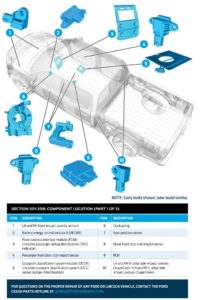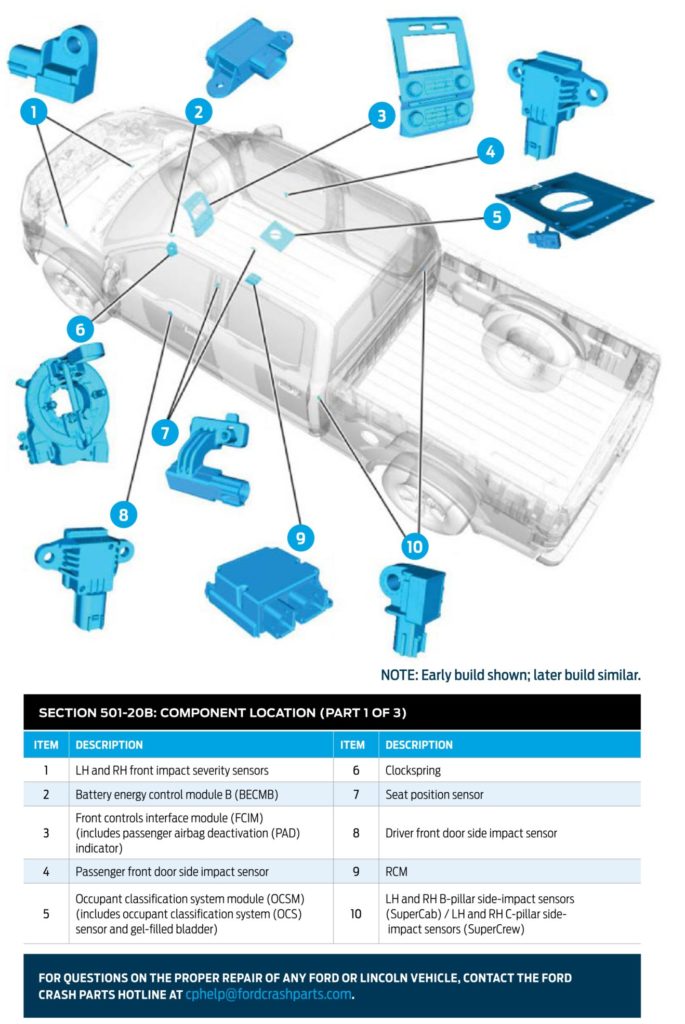
New Ford ‘On Target’ issued; highlights include launch of 2020 F-150 SRS education series
By onAnnouncements | Education | Repair Operations | Technology
Ford’s latest free “On Target” newsletter for professional auto body shops has hit the stand, and repairers should take advantage of the industry resource.
While cautioning that none of the content represents a substitute for the official Ford and Lincoln OEM repair procedures, the quarterly “On Target” publications provide opportunities for collision repairers to familiarize themselves with vehicle technology and procedures.
The newest issue, for example, explains elements of some of the 2020 Ford F-150 SRS components you might be R&Ring or R&Ing.
The first of a series on the truck’s supplemental restraint systems, the article is notable for reminding repairers the sheer number of parts that make up the truck’s SRS platform.
Ford shows off a diagram of 10 part or part sets on an “Early build” of the F-150 — and it hasn’t even got to the airbags or seat belts yet. In fact, the newsletter calls the 10 parts “PART 1 OF THREE.”
We checked the actual OEM repair procedures for a generic 2020 F-150 using the official OEM procedure website www.motorcraftservice.com. (An option to search for your customer’s specific VIN also exists.) Spoiler alert: The truck has at least 27 SRS parts or part sets.
Understanding them and their particular nuances could be helpful in both protecting a customer and educating insurers.
For example, Ford explains how the restraints control module actually works during a collision.
“The restraints control module (RCM) continually receives and monitors inputs from the occupant classification system module (OCSM), battery energy control module B (BECMB) and various other hard-wired switches and sensors,” the OEM writes. “If the RCM detects a sudden vehicle deceleration and/or lateral deceleration based on the information received from the various sensors, and determines that deployment is necessary, the RCM applies voltage and current to deploy the appropriate SRS components.”
Ford also educates readers about the tabs you might find on certain SRS components and how they might trigger the airbag dash light.
“The SRS utilizes connector position assurance (CPA) tabs on deployable component connectors,” Ford wrote.
“… If the connector is attached to the deployable component yet the tab is not fully seated, the pins of the connector will still contact the deployable component pins. However, because the tab is not fully seated and the shorting bars are still applied to the deployable component pins, the RCM detects a fault (circuit resistance below threshold) during self-diagnostics when the vehicle is powered on (airbag warning indicator is illuminated).”
Find more in the latest free “On Target,” found on the repairer-facing FordCrashParts.com website. (There’s a bunch of other great free stuff there as well.) Other highlights include:
- A look at the frame on a 2020 Lincoln Aviator/Ford Explorer and the body of a 2020 Lincoln Corsair.
- Details on the Blind Spot Information System and Lane Keeping System advanced driver assistance systems on a Ford F-150.
- How to install and remove a 2019 Ranger front door skin. Also, an announcement you can buy box and cab assemblies for the Ranger.
More information:
Ford fourth-quarter 2020 On Target
Ford, Dec. 7, 2020
Ford and Lincoln official OEM procedures
Featured images: The fourth-quarter 2020 Ford On Target includes a diagram of some of the supplemental restraint system parts on a 2020 Ford F-150. A Ford key indicates the No. 10 side-impact sensor locations might change based upon the cab configuration of the F-150. (Provided by Ford)

